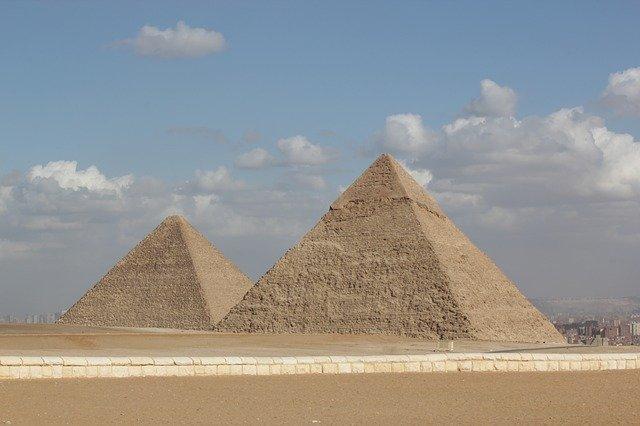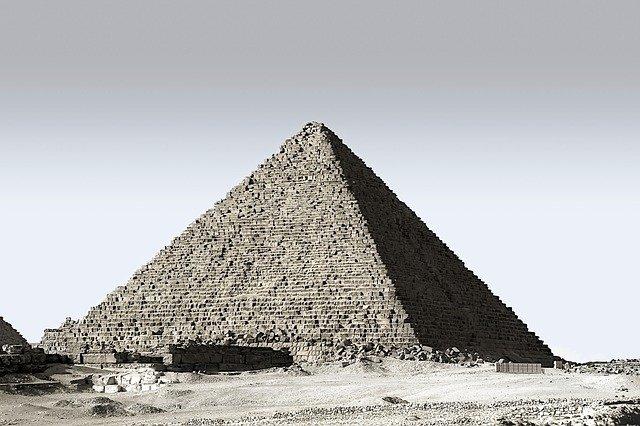How the Egyptian pyramids were built: theories that modern scientists recognize

One of the greatest mysteries in human history is the engineering feat of the ancients that led to the creation of the great pyramids of Egypt. For millennia, historians, architects, and scientists have tried to find an explanation for the appearance of these gigantic structures.
The mystery has not been fully solved to this day, and no one knows exactly how it was done. Unsurprisingly, many different explanations have emerged, and in this roundup of 10 of the most viable theories for constructing the Great Pyramids.
Ancient machines
Naturally, the first thought that comes to mind when thinking about building a building is the need to use cranes to lift and transport heavy pieces of metal or stone. The first pyramids were stepped pyramids with large flat surfaces on which heavy cranes could stand and operate. But, of course, ancient cultures knew about levers and pulley systems, and they probably used something similar to create the first pyramids.

However, the version of cranes or so-called “cranes” is not particularly plausible in the case of the Great Pyramids of Egypt explanation, as the surfaces were too small to accommodate hoists of this magnitude.
The pyramids were originally hills
An interesting but bizarre explanation for the appearance of the pyramids is that they originally arose as natural rock formations. Then stone blocks were laid out along the slopes of these hills from top to bottom.
A similar idea was first proposed in 1884 in The Fort Wayne Journal-Gazette at a conference of scholars. Perhaps this is what Herodotus had in mind when he said that the pyramids were built “from top to bottom.”
Polishing and levelling by hand
One of the most difficult and mysterious facts related to the construction of the pyramids is how the Egyptians could cut stones with such extreme precision that they could be stacked with virtually no gaps between them. As a result, it is impossible to squeeze even a sheet of paper into the junction between two stones.
Therefore, scientists are perplexed how the Egyptians achieved such precision in stone processing. Even today, it is impossible to recreate this with diamond cutters, let alone the most primitive hand tools. The following theory suggests that the Egyptians did not have any better tools than they do now. They just made much better use of what they had. For example, they allegedly levelled boulders using two poles of the same height, connected by a narrow rope, under which they placed the stone.
Limestone concrete
Perhaps an even more plausible way to achieve perfectly smooth stone surfaces was that the stones were made by pouring liquid limestone concrete into moulds. Again, there seems to be some evidence to support this theory.
Under a microscope, Egyptologist Jean-Philippe Lauer discovered air bubbles on the surface of the stones, indicating that air may have entered the liquid concrete.

According to the findings of the American Ceramic Society, it seems that the internal structure of the stones was formed in a process that happened very quickly, like the hardening of concrete.
Zigzag ramps
This is the first of various ramp theories. Straight ramp theories were not considered, as such a ramp would have to be larger than the pyramid itself and extend outward from it by 1.6 kilometers, given the assumed slope of 7 degrees.
For the ramp to make sense, it would have to be completed throughout the entire pyramid process. While a zigzag ramp would require less material than a straight ramp, this is almost as implausible as it would have to be constantly adjusted as the pyramid got taller. Therefore, such theories have been widely discredited.
Wet sand
Today, some supporters of the following theory believe that the stones for the pyramid were dragged over piles of sand, which were previously wetted to make the stones easier to move. This theory explains the transportation of stones from quarries hundreds of kilometers from the construction site and how the workers moved the stones upward with the help of some ramp.

But would a wet ramp provide sufficient stability for stones weighing up to 20 tons that needed to be lifted? Also, the question is how much-wet sand can support the feet of people who were dragging it all. At best, this theory can only explain the transportation of stones. As a method of raising stones, it fails.
Spiral ramp theory
While trying to develop a plausible theory of ramps, people eventually realized that the spiral ramp could be built at the same time as the pyramid. It will run along the outer part of the pyramid and continuously climb up as it is built. Proponents of this outer spiral ramp theory include Mark Lehner, an archaeologist at Yale University.
The main problem when using a spiral ramp is maneuvering stones. It is hard enough to drag huge rocks up the slope, but the need to constantly turn them to climb the spiral makes it even more difficult. This is why the outer spiral ramp theory is implausible.
The theory of water mines
Building a long underground dam underwater from a local water source a reasonable distance from the quarry and then using water “shafts” to lift rocks. This theory suggests that a water dam was used to transport stones and that the stones were carved and ground in the water.
After precise grinding of the stone, pieces of lightweight material were attached to it, ensuring buoyancy. Thus, the stone floated upward, and its surface was protected from impacts against other stones.
There is some evidence that similar water mines were used to construct structures in other parts of the world (for example, it is believed that the canals were used for the construction of Angkor Wat in Cambodia).
However, if such a channel was used to build the Great Pyramid at Giza, where did it go, and why it was destroyed, presumably, it took ten years to build. The length of the canal was supposed to be 10 kilometers since this is the distance from the Nile River to the site of the pyramid at Giza. In addition, even if this theory is correct, it still does not explain some of the other nuances in the pyramid.
Extraterrestrial intervention
The more time it takes to figure out how humans built the pyramids, the more the answer seems to suggest something else. Although scientists usually reject extraterrestrial interference, many Egyptologists and historians believe that the pyramids were built by aliens.

Hearing this theory, many will immediately laugh at it. However, extraterrestrial interference is no more “wild” theory compared to many others. Given everything that is known about the pyramids, it might be reasonable to conclude that the ancient cultures could not have built these incredible structures independently. Even with all modern technology, people today are completely unable to build pyramids like those in Egypt. Therefore, it seems incomprehensible that the ancient primitive civilization possessed both technologies.
The Great Pyramid of Giza faces almost exactly northward, with a deviation of only 3/60 degrees. Thus, it is even more aligned than the Royal Observatory in Greenwich, London, which points north at 9/60 degrees.
Another great mathematical feature of the Great Pyramid is that the perimeter divided by the height is 2π (deviations are negligible). Of course, a whole host of other precise mathematical numbers are associated with pyramids, but most importantly, you need to consider the speed with which they were built.
With 2.3 million stones weighing an average of 2.5 tons each, it is estimated that one stone needed to be installed every two minutes. This includes all the time it takes to perfectly cut the stones, move them for miles across the desert, climb the side of the pyramid, and then place them in place. It is very difficult to believe that primitive people did all this.
Jean-Pierre Gooden on the internal ramp theory
Recently, one person has been trying, independently of all others, to unravel the mystery of how the pyramids were built. This is a French architect named Jean-Pierre Gooden. Since the 1990s, he devoted all of his time to studying the Great Pyramid and was able to develop the most brilliant theory of pyramid construction ever created.
According to Gooden’s theory, the Great Pyramid was built using two separate spiral ramps. The first was an outer spiral ramp going up about 30 percent, and the second was an inner spiral ramp through which heavy stones were pulled to the very end.
Gooden calculated that this inner slope had a slope of 7 degrees. This spiral ramp also included open sections at the corners for workers to turn the blocks (believed that cranes were also used here). In addition to the inner ramp, Gooden was also able to explain how the King’s Chamber was built and the most mysterious room in the Great Pyramid, the Great Gallery.
Massive granite blocks to the King’s Chamber were dragged through the Great Gallery using a long system of pulleys.
Thus, the Great Gallery exists for quite practical purposes. Inside are signs that support this theory, such as wedge holes in the rocks. They are believed to have been used to support the pulley system. Using digital technology, a team of programmers was able to test this idea. They confirmed that Gooden’s drawings of the pyramid were mathematically consistent and that the inner ramp was plausible.
Most surprising, however, is that they were able to find evidence of the actual existence of the ramp by scanning the pyramid, which revealed a spiral image. Thus, it could very well be the remnants of an internal ramp. By far, this theory provides the most plausible explanation for how the pyramids were built.




